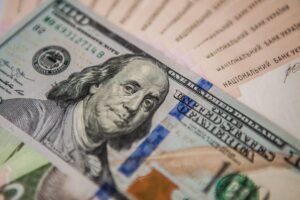
The first stage of the currency restrictions easing roadmap includes minimizing the multiplicity of exchange rates, liberalizing trade operations and facilitating new loans and investments.
The National Bank of Ukraine released the relevant public version of the Strategy to Ease Exchange Restrictions, Transition to a More Flexible Exchange Rate and Return to Inflation Targeting on Friday evening.
According to it, the second stage is liberalization of trade finance, management of currency risks of banks, the possibility of repatriation of interest on “old” debt obligations and investments.
Finally, the third stage includes the possibility of repayment of loans and investments, liberalization of household transactions and transactions in derivatives, the possibility of lending to non-residents and investments abroad.
As announced by the National Bank, the Roadmap and the Strategy have no specific calendar dates.
“Softening of currency restrictions is carried out gradually, taking into account the above priorities and is determined not by timeframes, but by the formation of appropriate macroeconomic prerequisites,” said the NBU.
According to the document, although the Roadmap defines the sequence of easing of currency restrictions, some steps (in particular, within the specified stages) may be implemented earlier or later than initially envisaged. This could happen if the conditions are such that a deviation from the stipulated sequence would be determined to be more beneficial to the economy, the currency market and the financial system.
The National Bank added that the easing of currency restrictions could occur gradually, in particular by changing the limits, calibration of levels, etc.
The regulator noted that the Roadmap reflects the following priorities: easing restrictions on transactions related to the movement of goods and services, then – related to capital flows and, finally, with its own foreign currency in respect of transactions at the expense of purchased foreign currency.
The NBU stressed that it will follow the general approach in which the refusal to fix the exchange rate will precede a large-scale liberalization of capital flows. “For its part, the increase in exchange rate flexibility will be preceded by the relaxation of most currency restrictions on trade transactions and restrictions that distort the functioning of the foreign exchange market because of the multiplicity of exchange rates,” the central bank added.
The National Bank added that during the implementation of the Strategy it will maintain tight monetary conditions by maintaining a sufficiently high level of real interest rates, which will ensure sufficient attractiveness of hryvnia assets and thus minimize the risks to exchange rate stability with the abandonment of the exchange rate fixing regime and the easing of currency restrictions.
According to the strategy, the NBU will base its decisions on the dynamics of the following key parameters: inflation and inflation expectations; the level of international reserves and foreign exchange market stability; interest rates and financial stability parameters.
“The appropriate preconditions and positive result of the conducted analysis have already allowed the NBU to soften a number of currency restrictions in June. At the same time, the prerequisites for the next steps of the Strategy are still forming,” the regulator noted.

The National Bank of Ukraine (NBU) has fined PJSC IC Kyivska Rus (Kyiv) UAH 391,000 for violating financial monitoring requirements.
According to the regulator’s website, the fine was imposed for improper fulfillment of the institution’s obligation to timely and fully provide information and/or documents, copies of documents or extracts from documents necessary to supervise the prevention and counteraction to the National Bank’s requests. As well as for the submission to the National Bank of reports on prevention and counteraction with errors
As Ukrainian News earlier reported, on May 8 the National Bank of Ukraine (NBU) applied to Kyivska Rus IC a sanction in the form of a temporary suspension of license to provide financial services in insurance due to failure to report for the first half of 2022 and for 2022, as well as the actuarial report for 2022.
The company also did not submit a report on corporate governance and information on the key risks and the results of stress testing for 2022, did not provide information and documents as required by the NBU.
The insurer has been set a deadline up to June 8, 2023 for elimination of violations.
Private JSC “IC “Kyivska Rus” performs activity in voluntary and obligatory types of insurance, other than life insurance.
According to the accounts of the insurer for nine months of 2022 the amount of insurance payments totaled 85,4 mln UAH of which 76,9 mln UAH were paid out by reinsurers. The insurer made no payments during the above period.

The National Bank of Ukraine on July 3 included Brokertim LLC in the State register of insurance and reinsurance brokers “, according to the website of the regulator.
According to Internet resources, “Brokertim” LLC was registered in July 2018. Its owner is stated LLC “DTEK Service”, the ultimate beneficiary of which is Rinat Akhmetov.
The authorized capital of the company is 625.7 thousand UAH.

National Bank of Ukraine (NBU) has applied the enforcement measures to IC “Greenwood Life Insurance” and IC “Alfa Insurance” (both Kiev) in the form of an obligation to take measures to remedy violations until July 17, 2023, according to the website of the regulator.
“Measures of influence are applied due to non-compliance with the requirements of paragraphs 1 and 11 of the NBU board resolution “On peculiarities of application of registration and licensing procedures of non-bank financial services market participants during martial law …”, – said in a message on the regulator’s website.
According to the document, it refers to written assurances of companies to the National Bank about the compliance of direct and ultimate owners of material participation to the requirements of the regulator on the financial / property status, documents to assess such a position and subsequent responses to the NBU request.
PrJSC “Greenwood Life Insurance” works in the Ukrainian life insurance market since 2007 as the successor of the insurance company “Guarantee Life”. The company is a part of financial and investment holding Green Globe Enterprises INC (USA, New York), which operates in the territory of Europe, Asia, America.
IC “Alfa Insurance” was founded in 2000. On December 5, 2022 NBU has applied to IC “Alfa Insurance” a measure of influence in the form of temporary suspension of the license to provide financial services. Due to the company’s non-compliance with the requirements of the Regulations on licensing and registration of financial service providers and the conditions of their activities in the provision of financial services…, namely, the requirements for business reputation of financial service providers.
ALFA INSURANCE, Greenwood Life Insurance, INSURERS, NATIONAL BANK

The National Bank of Ukraine (NBU) has excluded Elit Leasing LLC and Otokoch Ukraine LLC from the Register of Persons who are not financial institutions but have the right to provide certain financial services due to the revocation of all their licenses, according to the regulator’s website.
Besides, SS LOUN LLC and FC Global Financial Services LLC were excluded from the State register of financial institutions on the basis of their own applications.
From this register in connection with the decision of the National Bank to cancel all existing licenses to provide financial services also excluded CS Garantia LLC, FC Hunter LLC, Royal Capitol LLC, ORO Finance LLC, Invest Solutions Factor LLC, LLC Credit Continental.
The Committee for the supervision and regulation of the non-banking financial services markets adopted such decisions on June 23, 2023.

The National Bank announces a comprehensive review and updating of approaches to the application of fines to banks for key violations of anti-money laundering (AML/CFT) and currency legislation, a comparison of documents indicates an increase in individual fines from 2 to 8 times.
“(This) will help prevent banks from committing violations of legal requirements, increasing responsibility for their failure/inadequate implementation, as well as the effectiveness of the impact measure, its deterrent nature in order to change the approach to the proper organization of the bank, the functioning of an appropriate risk management system,” the NBU said in a press release on Friday.
It is specified that the amendments were introduced by the NBU №80 of June 21, which comes into force on June 24, 2023.
In particular, for the violation of financial monitoring the scale with the ceiling of fines now starts from UAH 1 million, while previously it was UAH 0.4 million, and after the step of UAH 10 million the new value of UAH 50 million with a saved ceiling of UAH 135.15 million, with the specification that this ceiling applies even if there are several violations.
The NBU specified that fines of up to UAH 50 mln may be imposed for violations of legislative requirements in the field of CDD / CFT risk management or for improper checks on customers, while banks may receive fines of up to UAH 1 mln for failure to comply with internal documents on CDD / CFT legislative requirements in this area.
Inappropriate application of the risk-oriented approach to PEP clients, in particular, setting them an unreasonable risk level, taking disproportionate measures in accordance with the risk category, will be subject to a fine of up to UAH 10 million.
Also, the limits of fines for key violations in the field of currency legislation were revised and increased. In particular, significant violations (from UAH 1 million per transaction or from UAH 10 million in total) in the order of settlement of currency transactions, foreign exchange trading, transfer of currency valuables, cross-border movement, failure to perform / improper performance by the bank of currency supervision, violations of security measures are now punishable by a fine of up to UAH 1 million, whereas previously there were UAH 0.4 million.
Small amounts of violations may now be fined up to UAH 400 thousand instead of the previous UAH 50 thousand.
Other significant violations of currency legislation by the bank, including preventing or hindering to check the employees of the National Bank, failure of the bank to carry out the analysis, check documents on currency operations – up to 1% of the registered authorized capital of the bank, whereas before there was a limit of 8 million UAH.